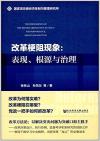
Zhang Linshan 张林山, Sun Fengyi 孙凤仪 et al.
Beijing: Social Sciences Academic Press (China), 2017.
Reviewed by: Diwen Xiao (Ph.D. Candidate, China, Social Policy, Sun Yat-sen University, HYI Chinese Politics Training Program Visiting Fellow)
In China, the creation of reform policies by the central government and their local-level implementation has always prompted fascination within academic circles and the general public. Yet, the majority of policy research done on such topics is mainly conducted by outsiders—such as university academics and journalists from the mass media—while actual opinions from insiders remains rare.
This newly published book, entitled The Phenomenon of Reform Obstruction in China: Performance, Origin and Solution, could be regarded as an exception. Authors of the book are working for the Economic System and Management Institute of China’s National Development and Reform Commission (NDRC), which is one of the official think tanks that decision-makers in the central government rely heavily upon. The two main contributors, based on their brief introductions, also have been actively involved in various decision making via policy drafting and consultation. This book has two main purposes, which are (1) exploring obstacles in the way of political reform and (2) providing reasonable advice in order to formulate a new approach to promote the Comprehensively Deepening Reforms blueprints, launched since the third Plenary Session of the 18th CPC Central Committee. It consists of eight chapters including one main report, five project reports and two investigation reports.
The authors endeavored to examine obstacles in three stages of the policy process: policy design and decision-making, policy implementation and evaluation, and finding better ways to promote reforms in the five key policy fields. In the main report, the authors illustrate six types of reform obstruction and attribute them to three categories of factors from mechanism deficit and interest consolidation to the concentration of power. A set of policy recommendations, under the name of a new approach to further the ongoing reform, is also attached. In the conclusion, the authors suggest that four major tasks need to be implemented, which include: (1) strengthening the domain role of the Central Leading Group for Comprehensively Deepening Reforms in decision-making, (2) improving the coordination among bureaucratic departments, (3) providing more freedom to local policy experiments, and (4) upgrading the policy surveillance and evaluation institution. Five project research reports, following the basic idea of the general report, provide a detailed analysis from different dimensions. All of the reports are also consultation-oriented rather than being catered solely towards academics. These reports focus on identifying policy problems and providing policy recommendations. Yet, most of the authors’ suggestions are not new when compared to previous studies and other consultative reports.
The most interesting aspect of this book, for researchers, proves to be the data provided in the investigation report on achievements and key obstructions of the reforms (Chapter 8). The data was collected from a survey in which seven major reform fields were covered. The survey was conducted among public servants from sub-branches of NDRC in six provinces and involved nearly 250 participants. The report consists of their comments and attitudes on various policy issues, such as policy design, policy implementation and coordination, and performance evaluation related to the implementation of the reform blueprint since November 2013. The other investigation report—based on interviews and a survey (only 13 questionnaires received) in Hubei province and Shenzhen—proves less valuable due to interview sources being rarely cited.
Amongst the public servants surveyed, four factors were highlighted, including the discontent of interest groups (bureaucratic departments especially), policy overproducing, poor coordination in policy implementation, shortage of supplementary policies for specific reform, and faulty political incentives to explain why reformative policy programs continue to be hung-up at the local level. The survey showed that discontent from bureaucratic departments and the unclear power division both at the horizontal and vertical levels proved to be two of the most troublesome obstacles. Compared to previous chapters, public servants from the NDRC attributed the reform obstructions to poor cooperation among bureaucratic departments rather than the policies themselves. In addition, most respondents shared the same comments about the low satisfaction of all ongoing reforms. The favorable rates, given by respondents, were all lower than 35%.
In sum, this book helps paint a more complete picture of the Comprehensively Deepening Reforms that have been so highly valued in Xi Jinping’s era. It could also potentially shed light on the state of government in China based on insiders’ attitudes and comments regarding policy implementation. Yet, it would be much more valuable and beneficial to academia if the interviews and forum memoranda could be attached.
